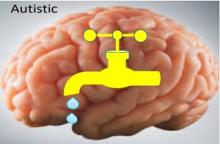- About us
- Research
- Students & Teaching
- Seminars & Events
- Directories
- Booking Rooms & Equipment
- עברית
Home » Prof. Atlas explains how can a single mutation in the voltage gated calcium channel induce autism
Timothy syndrome (TS) is a neurodevelopmental disorder caused by mutations in the pore-forming subunit α11.2 of the L-type voltage-gated Ca2+-channel Cav1.2, at positions G406R or G402S. Although both mutations cause cardiac arrhythmias, only Cav1.2G406R is associated with the autism-spectrum-disorder (ASD).
We show that transcriptional activation by Cav1.2G406R and Cav1.2G402S is driven by membrane depolarization through the Ras/ERK/CREB pathway in a process called excitation-transcription (ET) coupling, as previously shown for wt Cav1.2. This process requires the presence of the intracellular β-subunit of the channel. We found that only the autism-associated mutant Cav1.2G406R, as opposed to the non-autistic mutated channel Cav1.2G402S, exhibits a depolarization-independent CREB phosphorylation, and spontaneous transcription of cFos and MeCP2. A leftward voltage-shift typical of Cav1.2G406R activation, increases channel opening at subthreshold potentials, resulting in an enhanced channel activity, as opposed to a rightward shift in Cav1.2G402S.
We suggest that the enhanced spontaneous Cav1.2G406R activity accounts for the increase in basal transcriptional activation. This uncontroled transcriptional activation may result in the manifestation of long-term dysregulations such as autism.
Gating changes provide a mechanistic framework for understanding the molecular events underlying the autistic phenomena caused by the G406R Timothy mutation. They might clarify whether a constitutive transcriptional activation accompanies other VGCC that exhibit a leftward voltage-shift of activation and are also associated with long-term cognitive disorders
